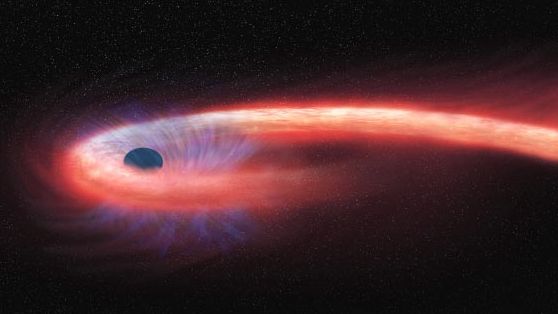
Filaments of material wrapped around a supermassive black hole have been spotted for the first time suggesting a star trapped by the black hole's gravity has just been destroyed by ”spaghettification”.
Astronomers believe that the effect more commonly known as tidal disruption, takes place because the black hole's gravity pulls more strongly on the side of the star closer to the black hole. The black hole first rips the star apart and then sucks in its matter, turning the star into a long filament in the process.
Previously, the only evidence of such a situation where a star met a violent demise venturing too close to a galaxy's center, came in the form of short bursts of electromagnetic radiation that astronomers occasionally observed emanating from supermassive black holes.
However, it wasn't until now that scientists have seen evidence of the actual physical filament from a star in the black hole's vicinity. In this new study, published in the journal Monthly Notices of the Royal Astronomical Society on March 24, a team of astronomers from the Netherlands Institute for Space Research (SRON) and Radboud University in the Netherlands has successfully detected such a spaghettified star in spectral absorption lines around the poles of a distant black hole.
Absorption lines are unusually dark lines detected in the otherwise continuous spectrum of electromagnetic radiation emitted by a source, in this case a black hole. These lines appear when material that absorbs part of the electromagnetic radiation (in this case the spaghettified star) obscures the source.
Related: Tiny newfound 'Unicorn' is closest known black hole to Earth
The astronomers observed the spectral absorption lines when looking at the black hole's rotational pole. The observation suggested that there was a strand of material wrapped multiple times around the black hole like a yarn ball, the scientists said in a statement on April 23. The team believes that this material is the torn star as it orbits around the black hole before disappearing inside of it.
Disks of accreted matter are known to exist around black hole's equators. Made of material that is drawn to but not yet swallowed up by the black hole, the disk orbits around the equator at a very high speed, emitting heat, X-rays and gamma-rays in the process.
The authors of the current study, however, claim that the material they were looking at wasn't part of the accretion disk.
"The absorption lines are narrow," said Giacomo Cannizzaro, the lead author of the paper. "They are not broadened by the Doppler effect, like you'd expect when you would be looking at a rotating disk."
The Doppler effect, caused by the fast motion of the material in the accretion disk, stretches or shrinks the electromagnetic waves depending on whether the source is moving towards or away from the observer. As a result, the light emitted by the part of the accretion disk that is moving away from Earth would be brighter. But the scientists saw no evidence of that.
The researchers also said in the statement that they knew they were facing the black hole's pole because they could detect X-rays. "The accretion disk is the only part of a black hole system that emits this type of radiation," the statement said. "If we were looking edge-on, we wouldn't see the accretion disk's X-rays."
Millions and even billions of times heavier than the sun, supermassive black holes are believed to lurk at the center of most galaxies. They grow over billions of years, swallowing up everything that falls into their gravitational embrace. Astronomers can detect black holes thanks to the bright X-rays they emit as they gorge on gas and matter from their surroundings.
Stars that orbit in the central parts of galaxies might occasionally wander so close to the black holes that they get trapped by their gravity. They get pulled closer and closer to the black hole and eventually die a premature death by spaghettification.
Follow Tereza Pultarova on Twitter @TerezaPultarova. Follow us on Twitter @Spacedotcom and on Facebook.
"time" - Google News
May 07, 2021 at 06:10PM
https://ift.tt/3vG8G1Q
'Spaghettified' star wrapped around a black hole spotted for the first time - Space.com
"time" - Google News
https://ift.tt/3f5iuuC
Shoes Man Tutorial
Pos News Update
Meme Update
Korean Entertainment News
Japan News Update
Bagikan Berita Ini














0 Response to "'Spaghettified' star wrapped around a black hole spotted for the first time - Space.com"
Post a Comment